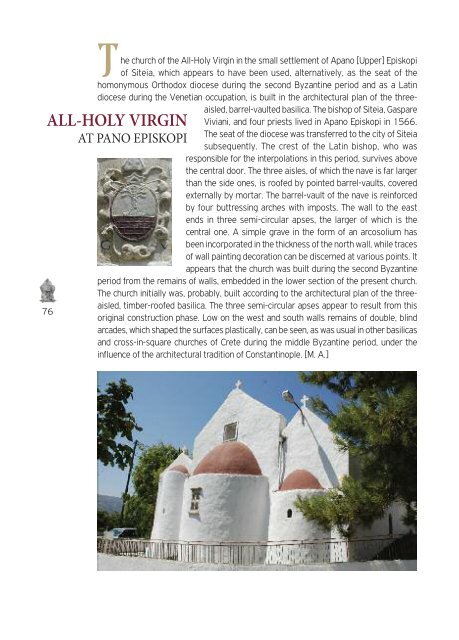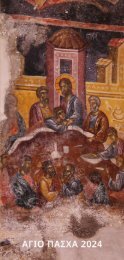Create successful ePaper yourself
Turn your PDF publications into a flip-book with our unique Google optimized e-Paper software.
The church of the All-Holy Virgin in the small settlement of Apano [Upper] Episkopi<br />
of Siteia, which appears to have been used, alternatively, as the seat of the<br />
homonymous Orthodox diocese during the second Byzantine period and as a Latin<br />
diocese during the Venetian occupation, is built in the architectural plan of the threeaisled,<br />
barrel-vaulted basilica. The bishop of Siteia, Gaspare<br />
ALL-HOLY VIRGIN<br />
AT PANO EPISKOPI<br />
76<br />
Viviani, and four priests lived in Apano Episkopi in 1566.<br />
The seat of the diocese was transferred to the city of Siteia<br />
subsequently. The crest of the Latin bishop, who was<br />
responsible for the interpolations in this period, survives above<br />
the central door. The three aisles, of which the nave is far larger<br />
than the side ones, is roofed by pointed barrel-vaults, covered<br />
externally by mortar. The barrel-vault of the nave is reinforced<br />
by four buttressing arches with imposts. The wall to the east<br />
ends in three semi-circular apses, the larger of which is the<br />
central one. A simple grave in the form of an arcosolium has<br />
been incorporated in the thickness of the north wall, while traces<br />
of wall painting decoration can be discerned at various points. It<br />
appears that the church was built during the second Byzantine<br />
period from the remains of walls, embedded in the lower section of the present church.<br />
The church initially was, probably, built according to the architectural plan of the threeaisled,<br />
timber-roofed basilica. The three semi-circular apses appear to result from this<br />
original construction phase. Low on the west and south walls remains of double, blind<br />
arcades, which shaped the surfaces plastically, can be seen, as was usual in other basilicas<br />
and cross-in-square churches of Crete during the middle Byzantine period, under the<br />
influence of the architectural tradition of Constantinople. [M. A.]<br />
he monastery of Toplou or the Akrotiriani [All-Holy Virgin of the Cape], as it is<br />
called due to its position in the eastern corner of Crete, is one of the most renowned<br />
and important monasteries of the island. Its establishment probably dates to the late<br />
14th century, a period during which the original catholicon was erected, dedicated to the<br />
Birth of the Theotokos. The monastery acquired its fortified form after its<br />
systematic plundering by Turkish pirates that raided eastern Crete at the<br />
end of the 15th century. Its reconstruction is connected to the Venetian-<br />
Cretan families of the Kornaroi and the Metzoi of Siteia according to<br />
tradition. The great earthquake of 1612<br />
caused serious damage to the monastic<br />
complex, which was restored anew by the<br />
scholar abbot, Gabriel Pantogalos, and with<br />
the contribution of the Venetian state. The<br />
church of the All-Holy Virgin was extended<br />
in this period with the expansion of the<br />
original aisle and the addition of the aisle<br />
of St. John the Theologian to the south.<br />
According to the historical testimonials, the<br />
17th century was a period of prosperity<br />
for the monastery that possessed large<br />
property, not only in eastern Crete, but also<br />
in the city of Chandakas. During the Turkish<br />
occupation, its function continued seamlessly, despite the fact that it endured many raids<br />
and damages, due to the participation of its monks in the liberation struggles. Its building<br />
complex, with a strong fort-like character, develops on three floors around a small<br />
courtyard to the south side of which is<br />
located the catholicon. The renaissance,<br />
two-storey belfry which rises on the roof<br />
of the western wing and the façade of<br />
the catholicon in which ancient, and<br />
contemporary with its erection,<br />
inscriptions have been embedded, such<br />
as that of the abbot, Gabriel Pantogalos,<br />
in elegiac couplets, are characteristic of<br />
the period during which the monastery<br />
received its final form. The interior of<br />
the catholicon whose original building<br />
today occupies the place of the<br />
sanctuary, presents special interest and<br />
has wall painting decoration of the<br />
second half of the 14th century with<br />
scenes from the cycles of Christ and the<br />
All-Holy Virgin.<br />
All-Holy Virgin ‘the Lady of the Cape.’<br />
HOLY MONASTERY OF<br />
TOPLOU<br />
77


















